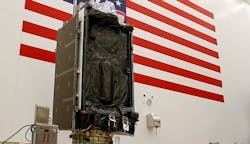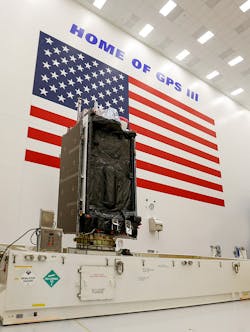The Global Positioning System (GPS) constellation of satellites upon which so many users rely upon for position, navigation and timing (PNT) services continues to receive an upgrade by the U.S. Space Force, the latest branch of the Armed Forces. (The first GPS satellites were launched by the U. S. DoD in 1978.) The accuracy and precision of the GPS system will be enhanced by the addition of next-generation GPS III satellites.
The third such satellite, built by Lockheed Martin, was recently shipped by Air Force C-17 aircraft to Cape Canaveral for launch later this year. The GPS III SV03 satellite was nicknamed “Columbus” in honor of the Italian explorer Christopher Columbus. Lockheed Martin may build as many as 32 of these next-generation GPS satellites as part of the modernization efforts. The satellites have about a 15-year operating lifetime, or about twice that of current-generation GPS satellites.
“Every day, more than four billion civil, commercial and military users rely on the [PNT] services provided by 31 GPS satellites launched since 1997,” said Tonya Ladwig, Lockheed Martin's Program Manager for GPS III. “We are excited to help the Space Force refresh the constellation to ensure U.S. and allied forces always have the best technology and that the U.S. Global Positioning System remains the gold standard for PNT.”
These latest GPS satellites offer much greater accuracy ad anti-jamming capabilities than earlier GPS satellites, with a modular design to allow for evolution of function and addition of features. For example, GPS III satellites will broadcast a fourth signal, for civilian use at 1575 MHz (L1 frequency), in addition to the existing two military signals and one shared civilian/military signal. Added functions and features include fully digital navigation payload, regional military protection capability, laser retroreflector array and search-and-rescue electronic system.
The new civilian signal will be shared by global international satellite navigation systems such as Galileo for improved worldwide positioning accuracy. “It’s an exciting time across the GPS mission as we bring together the best of our space, ground and operations systems to help the United States Space Force modernize this critical national capability,” said Johnathon Caldwell, Lockheed Martin’s vice president for Navigation Systems.
About the Author
Jack Browne
Technical Contributor
Jack Browne, Technical Contributor, has worked in technical publishing for over 30 years. He managed the content and production of three technical journals while at the American Institute of Physics, including Medical Physics and the Journal of Vacuum Science & Technology. He has been a Publisher and Editor for Penton Media, started the firm’s Wireless Symposium & Exhibition trade show in 1993, and currently serves as Technical Contributor for that company's Microwaves & RF magazine. Browne, who holds a BS in Mathematics from City College of New York and BA degrees in English and Philosophy from Fordham University, is a member of the IEEE.

